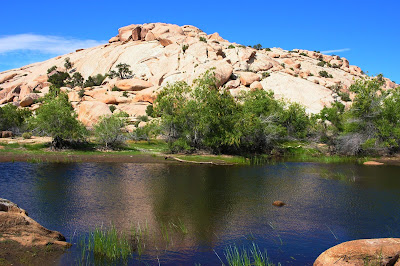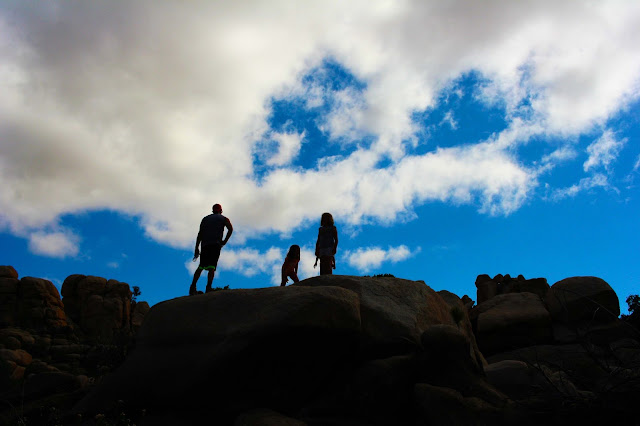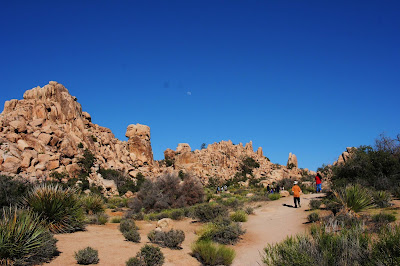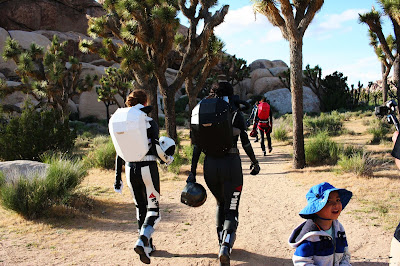CALIFORNIA: Joshua National Park
Joshua tree National Park
Joshua Tree National Park is immense, nearly 800,000 acres, and infinitely variable. It can seem unwelcoming, even brutal during the heat of summer when, in fact, it is delicate and extremely fragile. This is a land shaped by strong winds, sudden torrents of rain, and climatic extremes. Rainfall is sparse and unpredictable. Stream beds are usually dry and waterholes are few. Viewed in summer, this land may appear defeated and dead, but within this parched environment are intricate living systems waiting for the opportune moment to reproduce. The individuals, both plant and animal, that inhabit the park are not individualists. They depend on their entire ecosystem for survival.
Joshua trees take many different forms. Sometimes they are full and bushy, other times spindly and open in their overall shape. Spring rains may bring clusters of white-green flowers on long stalks at branch tips. Like all desert blooms, Joshua trees depend on just the perfect conditions: well-timed rains, and for the Joshua tree, a crisp winter freeze. When it is spring time, there are many unique, beautiful, and colorful flowers. Spring season are the perfect weather to explore Joshua Tree National Park. This is a great place for landscape photography, a great place to visit, to rock climb, to camp and to hike. The rock formations and breathtaking views that will stick in our mind!
 |  |  |
 |  |  |
 |  |  |

Barker Dam, also known as the Big Horn Dam, is a water-storage facility located in Joshua Tree National Park in California. The dam was constructed by early cattlemen, including CO Barker, in 1900. It was raised in 1949 by rancher William F. Keys. It is situated between Queen Valley and the Wonderland of Rocks near the Wall Street Mill. It is a gathering place for desert wildlife, including many species of birds and Desert Bighorn Sheep. Visitors can reach the dam via a short trail from a nearby parking lot and can see Native American petroglyphs a short distance to the west. There is also good bouldering on side trails near the dam. The park offers a Barker Dam Nature Hike led by a ranger. The lowest nine feet of the dam, the original portion, was constructed of concrete surfaced with stone on the downstream side. The height of the dam was raised an additional six feet with concrete in 1949-1950. The dam has several indentations.
The Barker Dam Loop trail is 1.5 miles (2.4 km) round trip and has little elevation gain. It goes from the parking lot at Barker Dam, past the dam and several good boulder climbing areas and a wall of petroglyphs. The trail offers good birding near the lake and at several spots along the trail that are surrounded by brush. It is a popular trail and is crowded midday.

 |  |  |
 |  |  |

 |  |  |
 |  |
Hidden Valley is a self-guiding, one-mile loop trail that winds among massive boulders through what was believed to be a legendary cattle rustlers' hideout. It is one of the most popular and scenic hiking trails in Joshua Tree National Park. The area is also a popular rock-climbing area. Many visitors enjoy just watching the climbers in action.
Because of the Hidden Valley's natural encasement, a unique micro-habitat brings together a wide range of plants and animals not typically found together in other sections of the Park. Healthy populations of Joshua Tree, pinyon, juniper and oak share space with mesquite, yucca, nolina, various cacti and other species.
According to various sources, in 1936, desert pioneer Bill Keys blasted a notch through the rocks walls to improve access for his cattle herds. Today this serves as Hidden Valley's main access point.
A nearby campground is available for renting and small RV's, 25' or less.

 |  |  |
 |  |  |
 |  |  |
 |  |  |
 |  |  |
 |  |  |

 |  |  |
Skull Rock is located along the main east-west park road, it is a favorite stop for park visitors. A parking spot is located just across the road from the rock. Skull rock began long ago when rain drops accumulated in tiny depressions and started to erode the granite. As more rock eroded, more water accumulated, leading to more erosion until, as time passed, two hollowed-out eye sockets formed and the rock began to resemble a skull.
For those wishing to stretch their legs, a 1.7-mile nature trail begins either just across from the entrance to Jumbo Rocks Campground or inside the campground, across from the amphitheater.

 |  |

 |  |  |

Sunset in Joshua Tree National Park
 |  |
 |  |  |
 |  |
There are 131 miles (210.8 kilometers) by car from Los Angeles to Joshua Tree National Park, following the I-10 E route.
Los Angeles to Joshua Tree National Park are 2 hours 10 minutes (depends on the traffic) far apart, if you drive non-stop.
If you are planning to have a weekend getaways, (click here).
* I love to hear about your trip (where did you go? how's your experience?) share it by commenting below. :)





Wow! A very nice place to hike. I would love to add this on my bucket list.thank you for sharing Ms.Mishyl
ReplyDeleteYour welcome!
Delete